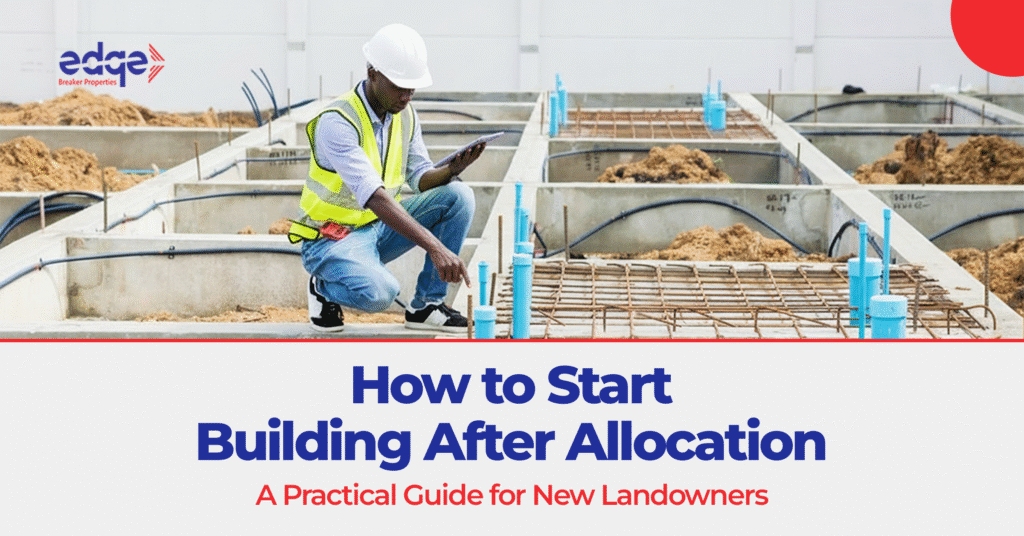How to Start Building After Allocation.
Receiving your land allocation is an exciting milestone — it’s the moment your dream of ownership becomes real.
However, for many investors and homeowners, the question that follows is simple yet crucial: “What next?”

Starting construction after allocation requires more than enthusiasm; it requires strategy, planning, and compliance.
Whether you’re building your dream home or a commercial structure, the right approach determines how smoothly your project will progress.
- Verify Your Land Documents
Before you begin any physical work, ensure that all your allocation documents are complete and authentic.
Key documents to confirm include:
• Allocation Letter
• Survey Plan
• Deed of Assignment or Contract of Sale
• Approved Layout Plan (if applicable)
If your estate provides a unified documentation process, liaise with the management or developer to confirm your plot coordinates and boundaries.
This verification step prevents future disputes or encroachments.
2. Conduct a Proper Land Survey
Engage a registered surveyor to inspect and peg the exact boundaries of your plot. This step ensures that your building aligns with the approved layout and prevents you from building beyond your allocated space.
It also helps you visualize how your structure will sit on the land.
3. Obtain Building Approval
Next, approach the appropriate town planning authority to obtain your building plan approval.
You will typically need to submit:
• Architectural Drawings
• Structural and Mechanical Plans
• Survey Plan and Title Documents
Building without approval can lead to government penalties, demolition, or project delays.
Always secure your permits first, it’s the foundation of legal and safe construction.
4. Engage Qualified Professionals
Hiring the right team is essential. Engage:
• Architect: To design within your budget and estate specifications
• Structural Engineer: To ensure safety and stability
• Builder or Project Manager: To supervise construction
• Quantity Surveyor: For cost estimates and material management
This professional team will help you balance quality, compliance, and cost-effectiveness throughout your project.
5. Plan Your Budget and Phases
Construction is capital-intensive, so having a clear budget and phased plan is vital. Outline your project in stages, foundation, structure, roofing, finishing and plan your finances accordingly.
Avoid starting without a financial roadmap.
A well-structured budget keeps your project moving even when economic conditions fluctuate.
6. Clear and Prepare the Site
Once all approvals and plans are in place, begin site clearing, removing debris, weeds, and temporary pegs. After clearing, conduct soil tests (if necessary) to determine the best foundation type for your building.
Proper site preparation ensures durability and prevents future structural issues.
7. Begin Construction the Right Way
Start with setting out (marking your building lines), followed by foundation work.
• Throughout construction:
• Adhere strictly to your approved plan
• Ensure quality materials are used
• Supervise or engage a project manager for consistent oversight
Remember: it’s better to build right once than to rebuild later due to poor workmanship.
8. Maintain Communication with Estate Management
When your land is within an estate, stay in touch with the estate management or developer. They may have construction guidelines, approved building types, and environmental standards you must follow. Keeping them updated helps you avoid penalties and ensures your structure aligns with the estate’s overall vision.
9. Prioritize Safety and Quality
Safety is non-negotiable. Ensure all workers are equipped with safety gear, and maintain a clean, organized site. Always prioritize structural integrity over shortcuts, the safety of your family or future occupants depends on it.
10. Keep Records and Monitor Progress
Document every stage of your building journey, approvals, receipts, progress photos, and contractor details.
Regular supervision ensures your project stays on track, within budget, and meets your expectations.
Final Thought
Starting to build after allocation is more than just breaking ground — it’s about building with foresight, compliance, and confidence.
When you approach construction with the right professionals, proper documentation, and a clear plan, your land transforms seamlessly into a lasting legacy.
Edge Breaker Properties
Empowering You to Build Smart, Secure, and with Confidence.
{Marketing Department}

